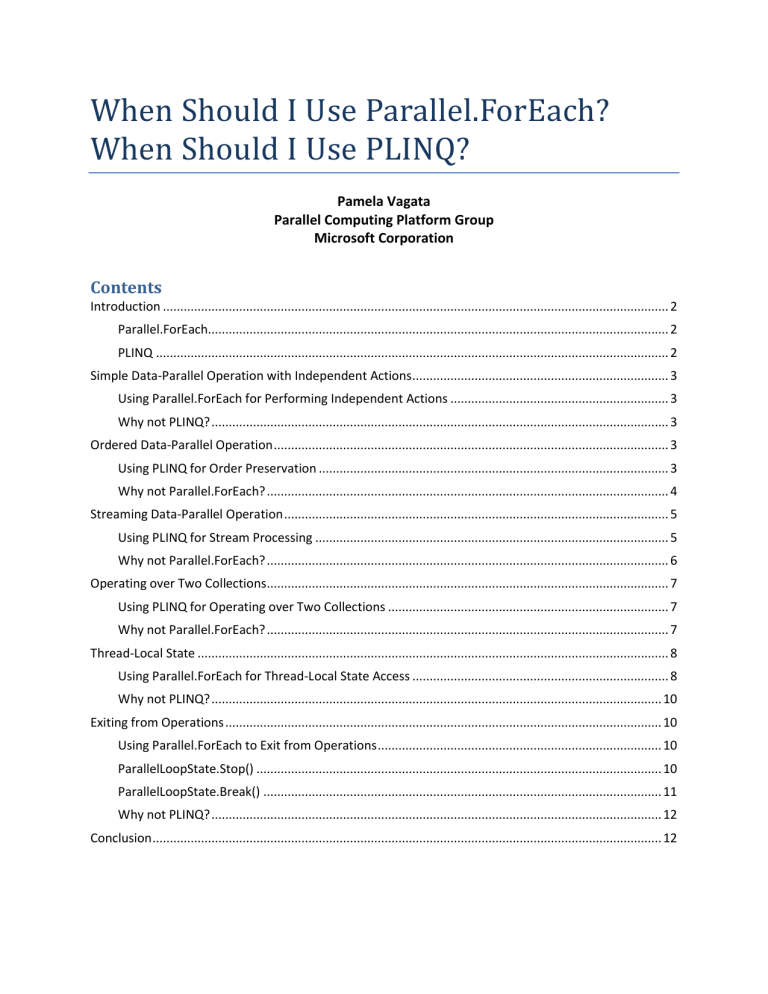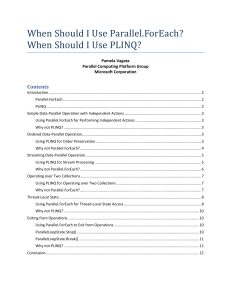Parallel.ForEach vs PLINQ: When to Use Which
advertisement

When Should I Use Parallel.ForEach?
When Should I Use PLINQ?
Pamela Vagata
Parallel Computing Platform Group
Microsoft Corporation
Contents
Introduction .................................................................................................................................................. 2
Parallel.ForEach..................................................................................................................................... 2
PLINQ .................................................................................................................................................... 2
Simple Data-Parallel Operation with Independent Actions .......................................................................... 3
Using Parallel.ForEach for Performing Independent Actions ............................................................... 3
Why not PLINQ? .................................................................................................................................... 3
Ordered Data-Parallel Operation .................................................................................................................. 3
Using PLINQ for Order Preservation ..................................................................................................... 3
Why not Parallel.ForEach? .................................................................................................................... 4
Streaming Data-Parallel Operation ............................................................................................................... 5
Using PLINQ for Stream Processing ...................................................................................................... 5
Why not Parallel.ForEach? .................................................................................................................... 6
Operating over Two Collections.................................................................................................................... 7
Using PLINQ for Operating over Two Collections ................................................................................. 7
Why not Parallel.ForEach? .................................................................................................................... 7
Thread-Local State ........................................................................................................................................ 8
Using Parallel.ForEach for Thread-Local State Access .......................................................................... 8
Why not PLINQ? .................................................................................................................................. 10
Exiting from Operations .............................................................................................................................. 10
Using Parallel.ForEach to Exit from Operations .................................................................................. 10
ParallelLoopState.Stop() ..................................................................................................................... 10
ParallelLoopState.Break() ................................................................................................................... 11
Why not PLINQ? .................................................................................................................................. 12
Conclusion ................................................................................................................................................... 12
Introduction
When you need to optimize a program for multi-core machines, a great place to start is by asking if your program
can be split up into parts that can execute in parallel. If your solution can be viewed as a compute-intensive
operation performed on each element in a large data set in parallel, it is a prime candidate for taking advantage of
new data-parallel programming capabilities in .NET Framework 4: Parallel.ForEach and Parallel LINQ (PLINQ).
This document will familiarize you with Parallel.ForEach and PLINQ, discuss how to use these technologies and
explain the specific scenarios that lend themselves to each technology.
Parallel.ForEach
The Parallel class’s ForEach method is a multi-threaded implementation of a common loop construct in C#, the
foreach loop. Recall that a foreach loop allows you to iterate over an enumerable data set represented using
an IEnumerable<T>. Parallel.ForEach is similar to a foreach loop in that it iterates over an enumerable data
set, but unlike foreach, Parallel.ForEach uses multiple threads to evaluate different invocations of the loop
body. As it turns out, these characteristics make Parallel.ForEach a broadly useful mechanism for data-parallel
programming.
In order to evaluate a function over a sequence in parallel, an important thing to consider is how to break the
iteration space into smaller pieces that can be processed in parallel. This partitioning allows each thread to
evaluate the loop body over one partition.
Parallel.ForEach has numerous overloads; the most commonly used has the following signature:
public static ParallelLoopResult ForEach<TSource>(
IEnumerable<TSource> source,
Action<TSource> body)
The IEnumerable<TSource> source specifies the sequence to iterate over, and the Action<TSource> body
specifies the delegate to invoke for each element. For the sake of simplicity, we won’t explain the details of the
other signatures of Parallel.ForEach; the list of different overloads can be found here.
PLINQ
Akin to Parallel.ForEach, PLINQ is also a programming model for executing data-parallel operations. The user
defines a data-parallel operation by combining various predefined set-based operators such as projections, filters,
aggregations, and so forth. Since LINQ is declarative, PLINQ is able to step in and handle parallelizing the query on
the user’s behalf. Similarly to Parallel.ForEach, PLINQ achieves parallelism by partitioning the input sequence
and processing different input elements on different threads.
While each of these tools deserves an article on its own, this information is beyond to scope of this document.
Rather, the document will focus on the interesting differences between the two approaches to data parallelism.
Specifically, this document will cover the scenarios when it makes sense to use Parallel.ForEach instead of
PLINQ, and vice versa.
Simple Data-Parallel Operation with Independent Actions
A data-parallel operation with independent actions involves executing a computationally-expensive action with no
return value.
Using Parallel.ForEach for Performing Independent Actions
The independent action pattern can be achieved with the usage of any Parallel.ForEach signature, since all
Parallel.ForEach overloads are unified by this capability; if you use the overload mentioned above, the code
would look as follows:
public static void IndependentAction(
IEnumerable<T> source, Action<T> action)
{
Parallel.ForEach(source, element => action(element));
}
In this sample, action(element) represents the computationally expensive action you would perform per
element.
Why not PLINQ?
While PLINQ has the ForAll operator, it may be easier to think in terms of parallel loops rather than parallel
queries for this type of scenario. Furthermore, PLINQ may be too heavyweight for a simple independent action.
With Parallel.ForEach, you can specify ParallelOptions.MaxDegreeOfParallelism, which specifies
that at most N threads are required. Thus, if the ThreadPool’s resources are scarce, even if the number of available
threads is less than N, those threads will begin assisting the execution of Parallel.ForEach. As more threads
become available, those resources will then be used for execution of the loop’s body delegate as well. However,
PLINQ requires exactly N threads, which is specified by using the WithDegreeOfParallelism() extension
method. In other words, for PLINQ N represents the number of threads which are actively involved in the PLINQ
query.
Ordered Data-Parallel Operation
Using PLINQ for Order Preservation
If your operation requires the output to preserve the ordering of the input data set, you will probably find it easier
to use PLINQ rather than Parallel.ForEach. With PLINQ, the AsOrdered() operator will automatically
handle the order preservation of the input sequence when executing the subsequent queries and abstract away
the explicit index management and result storing details. It does so by reading the elements from the input data
set, partitioning the data set, computing the results in parallel, and finally arranging the results into the correctlyordered output sequence. For example, if you wanted to transform the frames in a movie from RGB to grayscale,
the resulting movie would be incorrect unless the original ordering of the frames was preserved. Here is how you’d
use an order-preserving query to process the bitmap frames in a movie in parallel, and then iterate over them in
the order in which the corresponding frames appeared in the input movie sequence:
public static void GrayscaleTransformation(IEnumerable<Frame> Movie)
{
var ProcessedMovie =
Movie
.AsParallel()
.AsOrdered()
.Select(frame => ConvertToGrayscale(frame));
foreach (var grayscaleFrame in ProcessedMovie)
{
// Movie frames will be evaluated lazily
}
}
The sample above demonstrates the succinctness with which order preservation can be expressed when using
PLINQ. The power of increased productivity goes hand in hand with the declarative nature of PLINQ. Instead of
worrying about how you will implement your solution such that the results are ordered in the same manner as the
input, you simply express what you would like to be accomplished using PLINQ operators. . By calling
AsOrdered() after AsParallel(), the transformed movie sequence will be in the correct order.
Why not Parallel.ForEach?
As mentioned before, order preservation is relevant when it comes to producing results that adhere to the original
ordering. While order-preserving data-parallel operations can be implemented using Parallel.ForEach, it
usually requires a considerable amount of work with the exception of a few trivial cases. As an example of such a
trivial case, you can use the following Parallel.ForEach overload to accomplish the effects of PLINQ’s
AsOrdered() operator:
public static ParallelLoopResult ForEach<TSource >(
IEnumerable<TSource> source,
Action<TSource, ParallelLoopState, Int64>
body)
This overload passes the index of the current element into the user delegate. Then, you can write the result out to
the same index in the output collection, compute the expensive operation in parallel, and finally use the indices to
correctly order the outputs. This sample demonstrates one of many ways to preserve order:
public static double [] PairwiseMultiply(
double[] v1,
double[] v2)
{
var length = Math.Min(v1.Length, v2.Lenth);
double[] result = new double[length];
Parallel.ForEach(v1,
(element, loopstate, elementIndex) =>
result[elementIndex] = element * v2[elementIndex]);
return result;
}
Note that in this sample, the input and output were fixed-size arrays, which made writing the results to the output
collection rather simple. However, the disadvantages to this approach become immediately obvious. If the original
collection were an IEnumerable rather than an array, you have 4 possible ways to implement order
preservation:
-
The first option involves taking the O(n) hit of calling the IEnumerable.Count() which effectively
iterates over the entire collection to return the number of elements. Then, you can allocate a properlysized array before calling Parallel.ForEach, and insert each result into the correct position in the
output sequence.
-
The second option would be to materialize the original collection before using it; in the event that your
input data set is prohibitively large, neither of the first two options will be feasible.
-
The third option involves some cleverness around your output collection. The output collection could be a
hashing data structure, in which case the amount of memory used just to store the output will be at least
2x the size of the input memory in order for the hashing data structure to get around collisions; it is
important to note that if your input size is large, the hashing data structure might be prohibitively large,
and would drive performance down due to false cache sharing and garbage collection pressure.
-
Finally, the last option would be to store the results along with their original indices, and implement your
own sorting algorithm to perform a sort on the output collection before returning the results.
With PLINQ, the user simply asks for order preservation, and the query engine will handle the messy details to
ensure that the results come out in the correct order. Since PLINQ’s infrastructure allows the AsOrdered()
operator to process streaming input, in other words, PLINQ allows the input to be lazily materialized. When using
PLINQ, materializing the entire output sequence is the worst case pitfall, and you can simply sidestep all the other
potential pitfalls mentioned above and perform your data-parallel operation with order preservation by using
AsOrdered().
Streaming Data-Parallel Operation
Using PLINQ for Stream Processing
PLINQ offers the capability of processing the query output as a stream. This ability is extremely valuable for several
reasons:
1. The results don’t have to be materialized in an array, thus, not all of it will have to coexist in memory at
any given point in time.
2. You can enumerate over the results on a single thread as they are getting produced.
Continuing with the Analyze Stocks example from above, suppose that you wanted to compute the risk of each
stock in a collection of stocks, filter out only the stocks which met a certain criteria of risk analysis, and then
perform some computation over the filtered results. The code would look something like this in PLINQ:
public static void AnalyzeStocks(IEnumerable<Stock> Stocks)
{
var StockRiskPortfolio =
Stocks
.AsParallel()
.AsOrdered()
.Select(stock => new { Stock = stock, Risk = ComputeRisk(stock)})
.Where(stockRisk => ExpensiveRiskAnalysis(stockRisk.Risk));
foreach (var stockRisk in StockRiskPortfolio)
{
SomeStockComputation(stockRisk.Risk);
// StockRiskPortfolio will be a stream of results
}
}
In the example above, the elements are distributed into partitions, processed with multiple threads and then
rearranged; it is important to understand that these stages will take place concurrently, and as soon as some
results are available, the single threaded consumer in the foreach loop can begin its computation. PLINQ
optimizes for throughput instead of latency, and uses buffers internally; so it may be the case that even if a
particular result has been computed, it may sit in an output buffer until the output buffer is fully saturated before
it is allowed to be processed. This can be alleviated by using PLINQ’s WithMergeOptions extension method,
which allows you to specify the output buffering. WithMergeOptions takes a ParallelMergeOptions
enumeration as the parameter; with this, you can specify how the query yields its final output when consumed by
a single thread. The choices you have are:
ParallelMergeOptions.NotBuffered: this specifies that each processed element is to be returned
from each thread as soon as it’s produced.
Parallel.MergeOptions.AutoBuffered: this specifies that the elements be collected into a buffer,
and the buffer’s contents are periodically yielded to the consuming thread all at once.
ParallelMergeOptions.FullyBuffered: this specifies buffering the entire output sequence, which
might allow the results to be produced faster than using the other options, but may also take longer to
yield the first element to the consuming thread.
An example on how to use WithMergeOptions is available on MSDN.
Why not Parallel.ForEach?
Let’s set aside the disadvantages of using Parallel.ForEach for order preservation. For the unordered case of
processing the result of a computation as a stream with Parallel.ForEach, the code would look as follows:
public static void AnalyzeStocks(IEnumerable<Stock> Stocks)
{
Parallel.ForEach(Stocks,
stock => {
var risk = ComputeRisk(stock);
if(ExpensiveRiskAnalysis(risk)
{
// stream processing
lock(myLock) { SomeStockComputation(risk) };
// store results
}
}
This is nearly identical to the PLINQ sample above, with the exception of explicit locking and less elegant code.
Note, in this situation Parallel.ForEach expects you to store your results in a thread-safe manner, while PLINQ
handles those details for you.
Recall that Parallel.ForEach’s body delegate is an Action <T> which returns void. In order to store results, we
have 3 options; the first is to store the resulting values in a collection which isn’t thread safe and therefore will
require locking on each write. The second option for storing the resulting values is to do so with a collection which
is lock-free and concurrent. Thankfully, instead of having to implement your own, .NET Framework 4 provides a
rich set of these collections in the System.Collections.Concurrent namespace. The third option for storing
result data involves using the thread-local signature of Parallel.ForEach and will be discussed in detail later.
Each of these options involves explicitly managing your side effects for simply writing results, all of which are
abstracted away by the PLINQ infrastructure.
Operating over Two Collections
Using PLINQ for Operating over Two Collections
PLINQ’s Zip operator specifically handles performing a computation while iterating over two separate collections
concurrently. Since it is composable with other query operators, you can perform any number of complex
operations on each collection in parallel before combining the collections. For example:
public static IEnumerable<T> Zipping<T>(IEnumerable<T> a, IEnumerable<T> b)
{
return
a
.AsParallel()
.AsOrdered()
.Select(element => ExpensiveComputation(element))
.Zip(
b
.AsParallel()
.AsOrdered()
.Select(element => DifferentExpensiveComputation(element)),
(a_element, b_element) => Combine(a_element,b_element));
}
The sample above demonstrates that each data source can be processed concurrently with different
computations; once the results are available from both sources, they can be combined with the Zip Operator.
Why not Parallel.ForEach?
Zipping can essentially be accomplished using the index-aware overload of Parallel.ForEach like so:
public static IEnumerable<T> Zipping<T>(IEnumerable<T> a, IEnumerable<T> b)
{
var numElements = Math.Min(a.Count(), b.Count());
var result = new T[numElements];
Parallel.ForEach(a,
(element, loopstate, index) =>
{
var a_element = ExpensiveComputation(element);
var b_element = DifferentExpensiveComputation(b.ElementAt(index));
result[index] = Combine(a_element, b_element);
});
return result;
}
However, there are potential pitfalls and disadvantages associated with attempting to combine two collections in
this fashion. The disadvantages include the same ones listed above in using Parallel.ForEach for order
preservation, and one of the pitfalls includes walking over the end of one collection since you are explicitly
managing the indices.
Thread-Local State
Using Parallel.ForEach for Thread-Local State Access
Even though PLINQ represents a more succinct mechanism for data-parallel operations, there are some dataparallel scenarios that are better suited for Parallel.ForEach, such as data-parallel operations that maintain
thread-local state. Parallel.ForEach’s most general thread-local selection signature looks like this:
public static ParallelLoopResult ForEach<TSource,
TLocal>(
IEnumerable<TSource> source,
Func<TLocal> localInit,
Func<TSource, ParallelLoopState, TLocal,
TLocal> body,
Action<TLocal> localFinally)
Note, there is an overload of Aggregate which allows accessing thread-local state, and can be used instead in the
event that your data parallel access pattern can be expressed as a reduction. The following example demonstrates
how to use this signature to filter out numbers that are not primes from a sequence:
public static List<R> Filtering<T,R>(IEnumerable<T>
source)
{
var results = new List<R>();
using (SemaphoreSlim sem = new SemaphoreSlim(1))
{
Parallel.ForEach(source,
() => new List<R>(),
(element, loopstate, localStorage) =>
{
bool filter = filterFunction(element);
if (filter)
localStorage.Add(element);
return localStorage;
},
(finalStorage) =>
{
lock(myLock)
{
results.AddRange(finalStorage)
};
});
}
return results;
}
While the functionality achieved here is certainly easier with PLINQ, this example is designed to illustrate that
when using Parallel.ForEach, thread-local state can be used to dramatically reduce the synchronization costs.
However, there are other scenarios where thread-local state becomes absolutely necessary; the next example will
demonstrate such a scenario
You, the brilliant computer scientist/statistician, have developed a statistical model for analyzing stock risk; this
model, you’re convinced, will put all other risk models to shame. In order to prove this however, you require some
data via stock reporting sites as well as your “secret ingredient”, a different piece of data which exists on the
internet. However, downloading all this data serially will take far too long and is an unnecessary bottleneck since
you have an eight core machine at your disposal. Although using Parallel.ForEach is an easy way to begin
concurrently downloading data using WebClient, each thread will be blocked on every download which can be
alleviated using Asynchronous I/O instead; more information on this is available here. For productivity reasons,
you decide to use a Parallel.ForEach anyway to iterate across your collection of URLs and download them
concurrently. The code looks something like this:
public static void UnsafeDownloadUrls ()
{
WebClient webclient = new WebClient();
Parallel.ForEach(urls,
(url,loopstate,index) =>
{
webclient.DownloadFile(url, filenames[index] + ".dat");
Console.WriteLine("{0}:{1}", Thread.CurrentThread.ManagedThreadId, url);
});
}
To your dismay, an exception is thrown at runtime: “System.NotSupportedException -> WebClient does not
support concurrent I/O operations.” Understanding that this means multiple threads may not access the same
WebClient at the same time, you decide to spawn one per URL:
public static void BAD_DownloadUrls ()
{
Parallel.ForEach(urls,
(url,loopstate,index) =>
{
WebClient webclient = new WebClient();
webclient.DownloadFile(url, filenames[index] + ".dat");
Console.WriteLine("{0}:{1}", Thread.CurrentThread.ManagedThreadId, url);
});
}
Because this leads to your program instantiating more than 100 WebClients, your program throws an exception
which informs you that your webclients are timing out. You realize that because your machine isn’t running a
server OS, there is a maximum limit on the number of simultaneous connections. You then realize that using the
thread-local signature of Parallel.ForEach will solve the problem, and the implementation looks something
like this:
public static void downloadUrlsSafe()
{
Parallel.ForEach(urls,
() => new WebClient(),
(url, loopstate, index, webclient) =>
{
webclient.DownloadFile(url, filenames[index]+".dat");
Console.WriteLine("{0}:{1}", Thread.CurrentThread.ManagedThreadId, url);
return webclient;
},
(webclient) => { });
}
In this case, each data access operation was entirely independent from one another. However, the point of access
was neither independent nor thread-safe. Using the thread-local storage allowed us to ensure that we spawned
just as many WebClient objects as were needed, and that each WebClient belonged to the thread that spawned
it.
Why not PLINQ?
If we were to implement the previous example with PLINQ using ThreadLocal<T> objects, it would look as
follows:
public static void downloadUrl()
{
var webclient = new ThreadLocal<WebClient>(()=> new WebClient ());
var res =
urls
.AsParallel()
.ForAll(
url =>
{
webclient.Value.DownloadFile(url, host[url] +".dat"));
Console.WriteLine("{0}:{1}",
Thread.CurrentThread.ManagedThreadId, url);
});
}
While this implementation will accomplish the same goals, it is important to realize that in any scenario, using the
ThreadLocal<> type is more costly than using the thread-local state overload of Parallel.ForEach. Note, in
this scenario, the cost of instantiating ThreadLocal<> is negligible when compared to the cost of downloading a file
from the web.
Exiting from Operations
Using Parallel.ForEach to Exit from Operations
For cases in which control flow is relevant, it is important to realize that exiting from a Parallel.ForEach loop
allows you to achieve the same effect as a control flow statement in a sequential loop while ensuring correctness.
Recall, some overloads of Parallel.ForEach allow you to track the ParallelLoopState, the most commonly
used signature looks like:
public static ParallelLoopResult ForEach<TSource >(
IEnumerable<TSource> source,
Action<TSource, ParallelLoopState> body)
The ParallelLoopState provides support for breaking out of a loop early by way of two separate methods, which
will be discussed in the next two sections.
ParallelLoopState.Stop()
Stop() informs the loop that it is unnecessary to start and execute more iterations and the loop will cease as
soon as possible; the ParallelLoopState.IsStopped property allows each iteration to detect when another
iteration has called Stop(). Stop() is typically useful in the case when your loop is performing an unordered
search, and can be exited once it has found what it is looking for. For example if you’re searching for any instance
of an object in a collection of objects, the code would look like this:
public static boolean FindAny<T,T>(IEnumerable<T> TSpace, T match) where T:
IEqualityComparer<T>
{
var matchFound = false;
Parallel.ForEach(TSpace,
(curValue, loopstate) =>
{
if (curValue.Equals(match) )
{
matchFound = true;
loopstate.Stop();
}
});
return matchFound;
}
While the functionality of this operation can be achieved with PLINQ, this example serves to
demonstrate how to use ParallelLoopState.Stop() as a control flow statement.
ParallelLoopState.Break()
Break() informs the loop that iterations belonging to elements preceding the current element still need to be
run, but iterations belonging to the elements that follow the current element need not be. The lowest iteration
from which Break() is called takes effect; this number can be retrieved from the
ParallelLoopState.LowestBreakIteration property. Break() is typically useful in the case that your loop
is performing an ordered search. In other words, some search criteria defines a given point up to which data needs
to be processed. For example, if you had a sequence with non-unique elements, and wanted to return the lowest
index of a matched object, the code would look something like this:
public static int FindLowestIndex<T,T>(IEnumerable<T> TSpace, T match) where
T: IEqualityComparer<T>
{
var loopResult = Parallel.ForEach(source,
(curValue, loopState, curIndex) =>
{
if (curValue.Equals(match))
{
loopState.Break();
}
});
var matchedIndex = loopResult.LowestBreakIteration;
return matchedIndex.HasValue ? matchedIndex : -1;
}
The example above would loop until an instance of the object was found, and signal Break(), indicating that only
elements with a lower index than the matched instance from the original sequence need to be iterated over; if
another match is found in this set of elements, Break() is signaled again, and this is repeated until there are no
more elements left , at which point the lowest iteration at which break() was called is the lowest index of the
element which matched.
Why not PLINQ?
Even though PLINQ provides support for exiting from within a query execution, the differences between PLINQ’s
exit mechanism and Parallel.ForEach are substantial. To exit from a PLINQ query, supply the query with a
cancellation token, as explained here. With Parallel.ForEach, exiting flags are polled on every iteration. In
PLINQ, the cancellation token is polled once every so often, so you cannot assume that a cancelled query will stop
quickly.
Conclusion
Parallel.ForEach and PLINQ are great tools to quickly inject parallelism into your applications without a steep
learning curve. When using these tools, keep in mind the differences and tips explained in this article, and always
choose the right tool for your problem.
This material is provided for informational purposes only. Microsoft makes no warranties, express or implied.
©2010 Microsoft Corporation.



